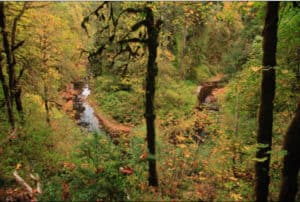Today President Trump signed the John D. Dingell, Jr. Conservation, Management, and
Recreation Act, which, among many other things, designates the Devil’s Staircase Wilderness. At over 30,000 acres, Devil’s Staircase now becomes the largest wilderness in Oregon’s Coast Range.
In the heart of timber country on the southern end of the Siuslaw national forest, the Smith and Umpqua Rivers define its boundaries. In the 1960s, the Forest Service imposed a moratorium on logging between these rivers pending completion of a soil erosion study. Although the study was inconclusive, the logging moratorium was lifted in 1980.
In 1984, when the Forest Service’s tried to resume logging, a federal district judge ruled the agency had violated the National Environmental Policy Act. The so-called “Mapleton” (named after the affected ranger district) injunction, stopping 700 million board feet of logging, was then the largest in U.S. history, surpassed only by the spotted owl lawsuit.
Speaking of spotted owls, Devil’s Staircase is home to the Coast Range’s highest numbers of these rare birds and the site of one of the decades-long spotted owl demographic studies. These studies provided much of the scientific foundation for the Northwest Forest Plan.

The one map I’ve seen shows some O&C parcels withing the new wilderness. Enough for a legal challege, a la Cascade-Siskyou National Monument?
One can’t challenge a law in court except as unconstitutional.
Except when two laws conflict with each other.
It is routine for Congress to pass new laws that change the management of federal lands from that provided for previously under older laws. In fact, that’s kinda what all wilderness designation laws do, right?
We’ll see what the courts say.
I had always thought that the Wilderness boundaries are drawn around the state and O&C lands. This is why the Utah State and Institutional Trust Land (SITLA) trade was such an important part of the Utah portions of the bill.
Devil’s Staircase is the third time Congress has designated O&C lands as wilderness. First, in 1978, was the Wild Rogue Wilderness. Second, in 1984, was Table Rock Wilderness.
State and private lands are not subject to wilderness designation by Congress. However, nothing prevents Congress from designating the federal lands that surround state or private in-holdings as wilderness. There are more than one million acres of wilderness-surrounded in-holdings.
The process of congressional wilderness designation is as in-depth and studied as any forest plan. Designation often begins with an agency recommendation based on forest planning. The executive branch weighs in with its views, which are informed by the land management agency. Devil’s Staircase, for example, was endorsed by both the Obama and Trump administrations in congressional testimony (“The proposed Devil’s Staircase Wilderness provides an outstanding representation of the Oregon Coast Range and would enhance the National Wilderness Preservation System”).
Right. I stand corrected. O&C are federal. Sorry.
Some info on the Cascade-Siskiyou National Monument litigation mentioned above. The hearing this refers to would have happened last week.
https://www.opb.org/news/article/oregon-pacific-northwest-cascade-siskiyou-monument-timber-industry/
The issue regarding the President’s exercise of authority under the Antiquities Act would be different than Congressional authority to change land management with legislation.